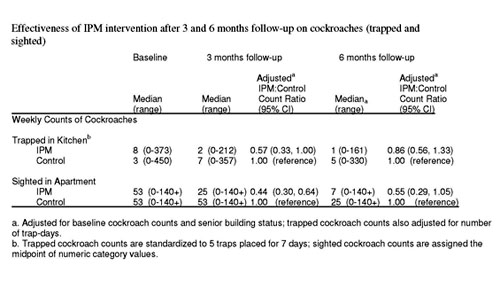21
Apr
New Study Finds “Single Visit” IPM Successful in NYC Public Housing
(Beyond Pesticides, April 21, 2009) According to a new study by the New York City (NYC) Department of Health, Columbia University and the NYC Housing Authority published in the online edition of Environmental Health Perspectives on April 15, 2009, “single visit” integrated pest management (IPM) at the building level (rather than individual rental units) is more successful than regular pesticide applications in managing public housing pests and allergens. The study, “Effectiveness of an Integrated Pest Management Intervention in Controlling Cockroaches, Mice and Allergens in New York City Public Housing,” is available online.
The NYC Housing Authority is the largest public housing owner in North America with more than 405,000 low-income residents. The successful implementation of IPM in an institution of this size was thought to offer many potential benefits; pesticide use reduction, improved pest management and reduced pest and allergen burdens in housing populated by largely African American and Latino families with a disproportionately high prevalence of asthma. Following a successful pilot program in public housing, the NYC Department of Health and Housing Authority developed an IPM intervention designed to be simple, low-cost and relatively easily scaled.
In buildings participating in the study, Housing Authority IPM teams spent 8-12 person-hours in each apartment unit. The teams employed mechanical and steam cleaning using soap in kitchens and bathrooms, used caulk to seal cracks and crevices, and applied boric acid and cockroach baits (gels or containerized solids containing fipronil or hydramethylnon) to kill remaining cockroaches. The IPM supervisor instructed apartment residents to store open food in sealed containers, cover garbage containers with a tight-fitting lid, and dispose of garbage frequently. Residents were provided with a covered garbage container, food storage containers and cleaning supplies, and were specifically asked not to use pesticides. The control buildings received usual care from the Housing Authority’s licensed pesticide applicators. Usual care consists of the offer of conventional, calendar-based extermination visits every three to six months.
Previous studies have shown that IPM is more successful and economical than traditional pesticide applications. The researchers from the city government believe that two features of the earlier studies limit their instructiveness for significant institutional replication and expansion. First, they have typically recruited from, and analyzed impact of IPM on individual rental apartments without building level interventions. Second, the studies, some of which involved goals beyond just pest control, have involved repeated visits by pest control professionals, cleaning services, or educators. The new study, in contrast, involves a single visit by pest control professionals with the intervention at the building level.
Compared to controls, apartments receiving IPM had significantly lower counts of cockroaches at three months, and greater success in reducing or sustaining low counts of cockroaches at three and six months. IPM was associated with lower cockroach allergen levels in kitchens at three months, and in beds and kitchens at six months. Pesticide use was reduced in IPM relative to control, apartments. Residents of IPM apartments also rated building services more positively.
For more information on IPM, see Beyond Pesticides children and schools, healthy hospitals, and state IPM webpages.











